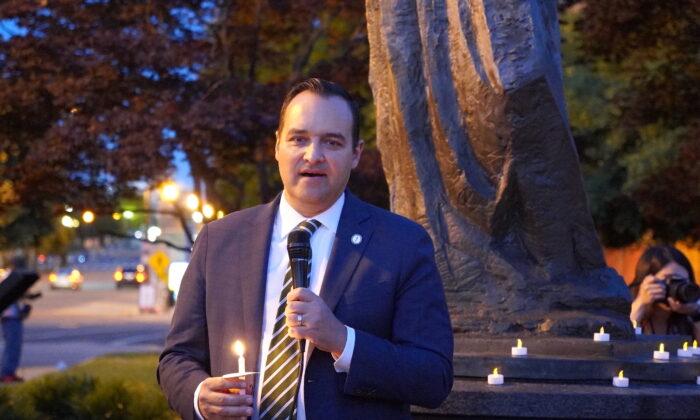WASHINGTON—The spirit of the Chinese student democracy movement lives on, said attendees of a candlelight vigil held in the nation’s capital commemorating the victims of the Tiananmen Square massacre at the hands of the Chinese Communist Party (CCP).
Thirty-three years ago, on June 3, 1989, CCP leaders ordered the military to remove the student-led demonstrators who had occupied Tiananmen Square for weeks demanding democracy in China. By the early morning of June 4, tanks and troops had cleared the area. Hundreds of students, if not more, were killed.
The “tank man,” an unidentified Chinese man who stood in front of a formation of tanks on June 5, 1989, became one of the movement’s most iconic images.
“We gather here today to carry on the memory of the brutal Tiananmen Square massacre that the CCP desperately wants the world to forget. But we will never forget,” said Ambassador Andrew Bremberg, president of the Victims of Communism Memorial Foundation (VOC), a Washington-based advocacy group.
He announced that the new Victims of Communism Museum in Washington would open on June 13 with a “Tiananmen 1989” exhibit.
The candlelight vigil hosted by VOC took place at the Victims of Communism Memorial statue near the U.S. Capitol. The figure is a replica of the “Goddess of Democracy” sculpture Chinese students erected in Tiananmen Square in May 1989. It was later destroyed during the violent clampdown in June.

Lee Edwards, VOC co-founder and chairman emeritus, called for participants to “take inspiration” from victims and “stand resolute until that day when China will be free China.”
“Dictators always look strongest just before they fall,” Edwards said, adding that Erich Honecker, the East German head of state, said in early 1989 that the Berlin Wall would last for 100 years. And it fell just months later.
In refuting the idea that the CCP would be everlasting, Edwards added, “A lot of people are beginning to realize that it is possible that the Chinese Communist Party will undergo severe pressures and tensions because of the faltering economy in China.”

The Chinese Spirit
Yang Jianli, president of the advocacy group Citizen Power Initiatives for China, quoted former U.S. President Reagan’s comment about the Tiananmen Square massacre, “You can’t massacre an idea.” Reagan said those words in London days after the incident while speaking at a lecture in memory of British wartime leader Winston Churchill.Yang said that the current times were difficult because “the space for civil society has been squeezed almost to zero” in China. Yet, the democratic yearnings of the Chinese people haven’t died; it will only take the right moment for people to speak out, according to Yang.
“I still have a very high hope for the people in China,” Yang told The Epoch Times. “Of course, we have to keep our movement alive overseas and sow seeds wherever we go. Then, someday we will harvest.”

To Joey Siu, a Hong Kong activist who left the territory at the end of 2020 as the CCP tightened its grip on the city, said the spirit of the 1989 student movement is “the dedication and the devotion to defending freedom and democracy and the values that we believe in.”
Siu was born in 1989 and learned about the Tiananmen Square massacre through newspapers and schooling in Hong Kong. Locals often refer to the movement as “June 4,” the day of the killings in 1989. HongKongers had held “June 4” candlelight vigils at Victoria Park every year until 2020, when the city refused the event to go ahead citing the pandemic. The vigil’s banning came amid a wider clampdown by Beijing on freedoms in the financial hub, which intensified after largescale pro-democracy protests in Hong Kong in 2019.
The activist said that the spirit of June 4 lived on in many HongKongers, citing the mass protests of 2019.
“Many young Hong Kong protesters quit school, sacrificing their future, and giving up well-paid jobs. Now we’re still seeing many activists doing the same, and I feel that is where we see the hopes of June 4th.”

‘No Gray Area’
Wu’er Kaixi, a student leader during the 1989 democracy movement and current general secretary of a human rights organization under Taiwan’s Legislative Yuan, said that the annual June 4th commemoration events served as a reminder of the CCP’s true nature to the world.“The enemy of freedom and democracy in China in 1989 is still the enemy of freedom and democracy 33 years later,” he told The Epoch Times. “This enemy is not just an enemy of the Chinese college students in 1989. It is also the enemy of the values of freedom and democracy.”





